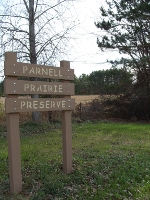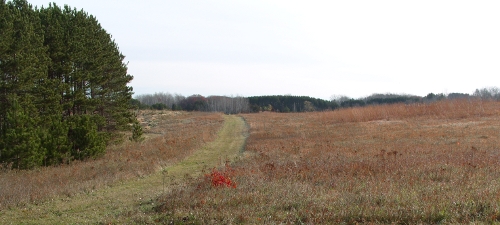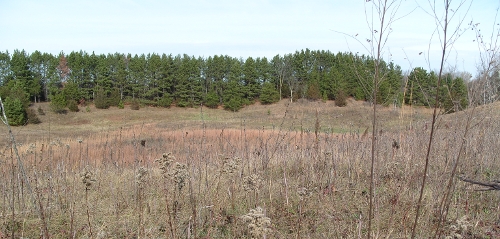
Location:
1823 45th St. Somerset WI
Parking:
Gravel lot for about 8 vehicles.
Facilities:
Mowed hiking paths. Foot travel only. Open 5am - 10pm. All DNR rules and hunting rules apply.
1.5 acres mowed hiking trails, and 30 acres restored prairie land.
Fees:
None
Description/History:
Opened 2010 as a cooperative park of Township and Village of Somerset WI on a reclaimed dump site. Prairie Preserve History in pdf format. Prairie burn planned for early April 2012 by Somerset Fire Department.
Somerset Dump and Parnell Prairie Preserve History
On April 7, 2010, “Parnell Prairie Preserve” was chosen as the name of the new Town and Village park by the Somerset Town Board.

As the project of turning the old Somerset dump into a prairie park has progressed over the last several years, there has been increased interest in the site’s history. Over its active life of 21 years (1967-88), the Somerset “town dump” on 45th Street near the railroad tracks represented an essential part of life for many Town and Village residents.

The Troubled Predecessor
The dump’s establishment in 1967 resolved the looming threat of state action over how the community handled its garbage and brought Town and Village together in a partnership that drew on the resources of both.
The predecessor to the town dump was a defacto Village dump. It was located in a gully between Spring Street and the Apple River, just south of today’s Float-Rite Park and screened from the (then) Terrace Night Club by a row of lilacs. It was free, unsupervised, infrequently tended, and used by both Town and Village residents, along with hundreds - if not thousands - of outsiders.
Commercial trash haulers were used less often then, and in rural areas with larger acreages, residents frequently used their own burn barrels, depressions, and ravines for refuse disposal. As one long-time Somerset resident, 92-year-old Adam Viellieux, recently observed, disposing of refuse then was a matter of “everybody for himself - you got rid of it where you could.”
Throwing old tires, appliances, etc. into ravines was, in fact, frequently thought of as a form of environmentalism, i.e., erosion control. Andy and Nancy Vanasse, who lived across the street from the Village dump for many years, suspect that may have been how that facility actually started. Once started, refuse not wanted anywhere else could be transported to the untended and open Village dump from miles away. Nancy remembers seeing untold numbers of weekend floaters and campers, many from Minnesota, make their last stop of the weekend across the street - to empty their vehicles of trash before heading home.
Unsightly and at times marked by fire, smoke, and odor, the Village dump was often the subject of complaints as a neighborhood nuisance. Village records from the 1960's show a regular monthly dump expense ($12) for rat poison service, and local youth frequently entertained themselves there shooting rodents. A storm sewer emptied into the gully, and heavy rains resulted in flowage through the dump and into the Apple River.
The gully was probably filled beyond capacity when the Village received a formal complaint from the State Board of Health in 1964. Village officials considered relocating the Village dump in 1964, possibly even prior to the State’s complaint, but felt stymied partly by questions related to the State’s possible re-routing of State Highway 35.
By mid-1966 they had installed fencing, formulated new regulations, and joined with Town officials to consider contracting with a “private dump owner” from Minnesota to establish a new dump outside the Village. By November of 1966 they were focusing on a particular Town site of “about 50 acres” in Section 33 that was available for an estimated cost of $125 per acre.
Six months later (May, 1967), the two boards decided to buy that site, and by early 1968, the new dump was in operation. It was owned jointly by Village and Town - with rules, restricted access, set hours of operation, paid caretaker, and room to expand.
Miles Wittig, a life-long Town resident known for his regular participation in Town meetings, recalls that at least three landowners had been interested in selling land for a dump site. He remembers being scolded by one whose land was not chosen.
Native Son Saw Community Need
The site selected for the new Somerset dump was owned by Albert (Alley) Parnell. Consisting of almost 50 acres along the Soo Line Railroad 2½ miles west of the Village, it was easily accessed from multiple directions off “Shortcut Road” (subsequently “Dump Road,” now 45th Street).
Alley was a native son and descendant of one of Somerset’s original pioneer families. He owned dairy and beef cattle, over 1000 acres of land, and a trucking business. Current town and village residents who knew him recall that he was active in town affairs and a good businessman who had a reputation for honesty and fairness. Miles Wittig, neighbor to Alley, says that Alley’s successful trucking business was due largely to the respect he enjoyed from many local farmers who trusted him to buy, sell, and transport their livestock to and from the St. Paul stockyards.
As much as six months or more before the joint Town and Village meeting (May, 1967) in which the decision was made to buy his land, Alley had made known its availability for a dump at a price of $125 per acre. When he appeared at the meeting to present his offer in person, the decision was made to buy it, create the new dump, and split the cost between Town and Village. Older residents recall land prices as beginning to escalate in those years.
Alley received half the agreed upon price shortly thereafter and with his wife (Gertrude) signed the deed over to the two municipalities on July 8, 1967. The remainder of the cost, apparently by informal agreement, was paid six months later.
A brief, formal agreement between Village and Town for operating the new dump was drawn up by the Doar & Knowles law firm of New Richmond and signed by officials in November, 1967. In it they acknowledged the joint purchase, agreed to share equally all maintenance costs including, if necessary, the hiring of a caretaker, and agreed to have rules for refuse disposal drawn up by their respective boards.
Current soil maps provided by the Natural Resource Conservation Service describe the general site as “well drained and somewhat excessively drained, nearly level to steep, medium textured and moderately coarse textured soils on glacial drift or outwash plains.” It was probably challenging to farm.
Alley’s daughter, Sharon Parnell of Stillwater, believes there may have been a small pond on the property that favored using it for grazing cattle and horses, but her father also planted some crops there. In any case, for two successive summers during the drought years of the 1930's, two of her brothers had the task, on horseback, of taking the animals on a daily ¾-mile trek to the St. Croix River bottoms for grazing around the islands.
As a teenager, Miles Wittig would sometimes milk cows for Alley when the latter’s hired man was on vacation. In later years, Miles and his family enjoyed the camaraderie of grain harvesting bees with Alley’s and 6-8 other nearby families, the men working long hours in the fields and the women in the kitchen of whichever family was host.
Alley always referred to the dump parcel as the “80.” One of Sharon’s favorite memories goes back to the fall when her dad was asked by a granddaughter to board her horse for the winter. He said he could but it would have to go out with the rest of the horses being wintered on the “80.” That was done, and when it came time to retrieve the horse the next spring, it was discovered - to everyone’s delight and surprise - to be accompanied by a healthy black colt.
Sharon remembers her dad as grateful for being able to live his entire life in the Somerset area and raise a family of 11 children there. When asked why he would part with a piece of land that would effectively put a dump almost in his backyard (¼-mile across the tracks), she can hear him pointing out the community’s need and expressing a sense of loyalty for what the community meant to him. The family respected his decision.
Problems of a New Landfill
Before the new Somerset dump opened, it was decided at a joint meeting of Village and Town boards in December,1967 that it would be open three days a week including Saturdays, with hours to be adjusted as needed. Signs would designate days and hours, and where to dump. The Village offered to provide shelter for the caretaker by moving a warming house from the village ice rink. The Town offered to use its tractor for grading refuse.
The exact opening date is unknown, but records from that December meeting indicate that the opening would occur when the State Board of Health gave approval and road access and fencing were improved. Miles Wittig lived nearby and recalls that some excavation was done to prepare the actual refuse site. In March,1968 the Town hired a part-time caretaker.
About six years after opening, the Town Board passed a resolution to amend the Sanitary Provisions of the county zoning ordinance, as it applied to the Town of Somerset, to prohibit the construction of wells providing water to humans or animals within ¼ mile of the landfill site.
A decision in the spring of 1976 to require all Village and Town dump users to acquire a (free) dump permit suggests that use by outsiders was a problem. Miles recalls that the gate was sometimes left open and people were leaving refuse at odd hours, some of it (refrigerators, mattresses, etc.) not considered appropriate for the landfill.
Because of complaints, the dump was upgraded in 1979 to a “sanitary landfill,” meaning that all waste at the site had to be covered at the end of each day it was open, except during winter months. All burning was banned. These restrictions were modified in 1980 to allow for burning wood and brush, and more importantly, for covering new dumping only once a month, saving Town/Village expense.
However, in August, 1986, three of the landfill’s neighbors notified the DNR (successor to the State Health Department in regulating the dump) in writing that they wished to withdraw their consent for open burning. The landfill had been burning garbage and as a result, the smoke and smell had become a nuisance and children with allergies and asthma were said to have trouble breathing. In September, the DNR again withdrew permission for all burning and reinstated the requirement that all waste be covered at the end of each day the dump was open.
Landfill use began to ease in the 1980's as the state and county began promoting recycling programs and tightening restrictions on landfills. In the first years of dump operation, the state licensing fee had been $25 annually, but a 1983 law defined the Somerset dump as a “non-approved facility” and initiated an annual licensing fee of $1000 plus several hundred more in tonnage fees. The base fee could be reduced to $100 by agreeing to close the landfill by July 1, 1999, which the Town and Village agreed to do.
Additional impetus for closing the dump came in 1987 as the St. Croix Waste-To-Energy Facility prepared to open in New Richmond. This plant was designed to burn most types of
municipal waste, with some exceptions, and convert it to steam energy. (The plant was unable to meet emission control standards and operated only briefly.)
Closure of the Somerset landfill began in the spring of 1988 and was officially completed on
September 1 of that year. Cedar Corporation of Menomonie was hired to engineer and guide the process at an estimated cost of $99,400. Existing scrap metal piles were buried, brush and wood
burned, and the surface graded. The entire 5½ acre refuse site was covered with 2 feet of fine-grained soils and 6 inches of topsoil, all taken from the area just to the east of the refuse site.
The Town arranged to have the covered refuse site seeded in August, 1988, and the parcel has been dormant and largely unused since that time.
A Dramatic, Bizarre Event and Near-Tragedy at Dump
Over its life of 21 years, there was no single day at the Somerset dump that involved more drama and bizarre, near-tragic history than October 18, 1972.
Joe Casey, Executive Officer of the Somerset Bank at the time, can still recall the exact moment (9:20 A.M.) the event began when a man with a ski mask over his face walked into the bank (now the Village Hall and Police Department) carrying a suitcase and two high-powered rifles, one in hand and one slung over his back.
Pointing the one gun at tellers and others present, he announced the holdup and instructed that the suitcase was to be filled with money if no one was to be hurt. The two tellers, with the help of a lone customer, proceeded to fill the suitcase with about $6200 and then retreated with Joe Casey and the customer into the vault, closing the door as instructed. As Joe entered the vault, he was able to de-activate the vault’s lock, so that the four hostages were able to exit immediately when they sensed the robber had left. The customer told a reporter later that he hadn’t been scared until he “was in the vault and thought that he couldn’t get out.”
As the four left the vault, they saw the robber driving off in the customer’s white Riviera (keys commonly were left in the ignition of cars parked in downtown Somerset) and turning west on State Highway 35/64.
While three of the hostages began notifying authorities and spreading the alarm, Joe Casey jumped in his car and followed the robber southwest to 38th Street and north to the dump, trying to keep just enough distance to not be noticed.
He watched the robber stop just past the dump entrance at the bottom of a hill, where he ditched his mask and suitcase (with the money) in the pines on the west side of the road and drove off again northward. Joe followed him around the circle - left on192nd Avenue to 37th Street, south to 180th Avenue, and east back to the dump.
Just as the robber was driving into the dump, Joe spotted Village Police Chief Dana Smith approaching in his patrol car and was able to apprise the chief of the situation. Chief Smith, followed by Joe, pulled into the dump driveway and emerged with his shotgun, possibly before his car had completely stopped rolling. There was an exchange of gunfire that resulted in the chief getting hit in an arm and hip.
As he fell back into his car (which was rolling into a ditch), the chief threw his gun toward Joe, who picked it up and yelled for the robber to stop. The robber raised his arms briefly as if to surrender, but then lowered them again and resumed firing as he ran southward toward the woods. He jumped a fence and disappeared with his guns over the railroad tracks.
It was several hours later when the robber, sans guns, entered Earl’s Bar (now Loch Ness Lounge) above Landing Hill, wanting to make a phone call. Something about his appearance or behavior, coupled with the alarms and warnings that had been blanketing airwaves and phone lines all day (schools and homes were in lockdown; FBI, local law enforcement, and armed citizens were staked out or patrolling everywhere) was enough to prompt contact with authorities and result in the robber’s arrest.
Lowell Peterson, who had just moved into his house near the dump a couple days before, heard the news and left work at Andersen Windows in mid-shift to check on his family. The FBI stopped him at the Stillwater bridge but allowed him to proceed. As he came up his driveway he saw a man on his deck with a rifle! It was an FBI agent who informed him that his family had been evacuated for reasons of safety.
Joe Jahnke, who had planned on going to the bank that morning to withdraw money for an elk hunting trip, remembers being called by his mother and advised to stay home because of all the hubbub in town with a robber on the loose. Later he heard that the robber had intended to hop a train as it neared the railroad’s High Bridge over the St. Croix.
The two rifles were found the next day - for a $200 reward - in the Landing Hill area by Harry Dieltz, Village Justice of the Peace.
Joe Casey’s memory is that the robber was eventually tried in federal court in Madison, but found to be mentally ill. He served little or no actual prison time.
Chief Dana Smith was to recover from his wounds, and the tumultuous day of October 18 ended without loss of life, limb, or significant cash (the bank somehow missing about $20). Plourde Hardware had had a run on guns and gloves (much of it apparently on credit), and a pervasive sense of relief and solidarity seemed to settle over the populace in the days following. As the Somerset Star’s Tom Dubey put it: “Try robbing the bank at Somerset...you’ll have the best darn people in the world after you.”
And there was one irony that might qualify as some form of poetic justice. The bank customer/hostage who had to help stuff the robber’s suitcase with money and submit to brief vault imprisonment - and whose Riviera was stolen for the get-away - was Earl Parent, owner of the bar where the robber went to make his phone call.
A Colorful Past and Hopeful Future
Going to the Somerset dump had its enjoyable aspects, especially for children. There were interesting things to see and perhaps even scavenge, and one well might run into friends and neighbors there. Adam Viellieux, a Town resident at the time, can still hear his children’s excitement when he announced a Saturday dump trip. “Dad’s going to the dump,” they yelled at one another before piling in the car.
Lenny Germain, currently a Town supervisor, remembers that as a kid his family’s Saturday morning routine was loading the week’s refuse into the trunk, going to the dump, and then heading over to “9R Ranch” (now the American Legion) for food, drinks (root beer for Lenny), and socializing with other families who followed the same routine.
Lowell Peterson, who lived a half mile away, remembers that his son’s trips past the dump on the way to or from school were made more adventurous by repeated sightings of a vagrant who lived there for weeks, if not months, among the pine trees in a crude lean-to.
Now, after being closed for 22 years and a period of relative obscurity, the former Town and Village dump is being prepared for a new role. If all goes as planned, its appearance in a few years may be close to what settlers saw when they first viewed the land in the mid-1800's,.
Somerset native Shawn Schottler, scientist with the Minnesota Science Museum and prairie expert (who also remembers the fun of going to the dump with his sister and father, looking for things to scavenge, and once seeing a bear) recently looked at the original land surveyor records for the site and was struck by the apparent lack of trees in the description. He noted that on August 9,1847 (about four years before the first settlers landed at the mouth of the Apple River), government surveyors described the south boundary of Section 33 (the landfill’s southern edge) as having no trees to use as bearing trees, forcing them to make a “mound of earth and sod” to mark corners. They described the property as “rolling, second-rate soil, (with) very sparse timber of oak and aspen.”
The current plan seeks to achieve authentic prairie within the existing perimeter of pines, allowing occasional groupings of oak and other native trees but emphasizing open spreads of grassland. Shawn believes that the site’s soil is perfect for a variety of cool season grasses and forbs that favor pheasants, endangered songbirds and butterflies, and other wildlife with specific plant/habitat requirements. He notes that there are existing prairie remnants on the edge of the site, particularly along the railroad tracks, that are genetically “pure” and which might augment a more standardized prairie seed mix with about 20 species uniquely adapted to the site.
Jim Riemer, wildlife biologist with US Fish and Wildlife who is heading up governmental funding and general direction for the project, has indicated that the selected tree/brush removal in March and controlled burn in April will be followed with grass/forb seeding this spring and spot chemical applications to unwanted invasive remnants this summer.
The prairie will provide a vista of color and texture to viewers as well as much needed wildlife habitat. A rustic trail system will allow hiking and ecological education. There may be a picnic table or two, and some benches at strategic points to sit and enjoy the view. There will be ample opportunity for school and community groups, prairie enthusiasts, and individual volunteers to participate in and/or help with trail building, signage, tours, seed collection, bird counts, etc.
When Adam Viellieux recently was reminiscing about his Saturday morning trips to the dump some 40 years ago with a carload of kids, his voice and facial expression brightened to reveal one treasured moment that for him was still as vivid as if it happened yesterday. It involved his 5-year-old son, who when looking at the windblown waves of grass on the railroad embankment along 180th Street, suddenly exclaimed, “Look, Daddy, the grass is running uphill!” Park planners hope the old pasture and dump site will soon allow kids - and their elders - more such moments.
